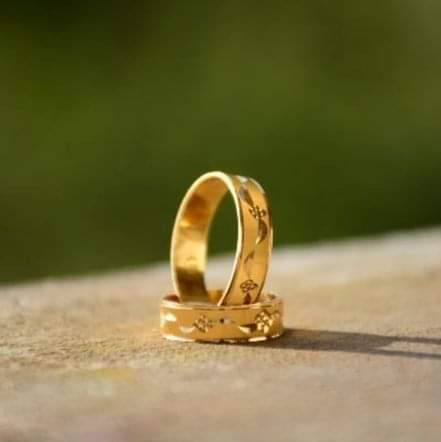Gold is one of the least reactive metals. However, we see that it loses its shine and colour in some circumstances. Ever wondered why does gold jewellery turn black? Ever thought about this and tried to get a solution for the same? Well, we have got you covered with reasons for gold discolouration and an effective solution to the question of how to clean gold that has turned black. This solution when brought into practice can return the lustre and colour of your gold as it was previously when newly bought. First, let’s explore the reasons for the discolouration of tarnishing of gold.
When a ring or different types of mangalsutra turn black or they discolor the skin, clothing, or the jewellery itself, some individuals believe that defective manufacture or undercoating is to blame. That is not the case, however. You may help prevent this from happening by understanding the underlying causes.
Metallic abrasion from cosmetics on the skin or clothing is the most typical cause. Cosmetics frequently contain substances that are harder than the jewellery itself, causing extremely few particles to wear or rub off. Finely divided metal appears black rather than metallic, giving it the appearance of jet-black dust. When this dust comes into touch with absorbent surfaces like skin or clothing, it adheres to the surface and forms a black smudge. To avoid this, try changing your cosmetics. If this isn’t possible, take off rings and other jewellery before putting them on, and wash any skin regions that come into contact with the jewellery with soap and water.
Corrosion of the metals is another factor. Gold does not corrode on its own, but its primary alloys of silver or copper do (producing highly dark chemical compounds) when exposed to moisture. Fats and fatty acids generated by perspiration can cause 14-carat gold to corrode, especially when exposed to heat and air. In seacoast and semitropical climates, where chlorides interact with perspiration to generate a corrosive element that discolours skin, the situation can be worse. Smog fumes progressively corrode jewellery, leaving a tarnish that rubs off on other surfaces.
Even the style of jewellery can have an impact. Wide shanks provide more surface area for abrasives and corrosives to interact. Concave surfaces within a shank serve as collection areas for moisture and pollutants, resulting in dermatitis. Thus, these were some reasons for gold tarnishing.
Now let’s talk about how to clean your Gold jewellery.
These simple steps can provide an effective and easy solution to your problem.
Step-1 Mixing of Warm Water and Soap
1 cup (240 ml) warm water, 1 teaspoon (4.9 ml) soap, 1 cup (240 ml) warm water Any glass jar with a capacity of at least 2 cups (470 ml) will suffice. To begin, measure out and pour your warm water into your container. Stir it with a spoon to combine it with your dishwashing soap.
Because ammonia might hurt the skin, you’ll need to perform this cleaning operation while wearing rubber gloves.
Step 2 Mixing Ammonia
1/2 teaspoon ammonia (2.5 mL) ammonia in water and dish soap Pour the ammonia into the glass container with care and stir with a spoon. Work in a well-ventilated environment because ammonia has a strong odour. If you’re doing this at home, open a window. If you can’t open a window or aren’t working in a well-ventilated area, wear a dust mask to keep harmful gases out of your lungs.
Step 3 Putting your Gold in the Mixture
For ten seconds, place your gold in the glass container. Hold it a few inches or centimetres above your solution’s surface and gently drop it. To avoid any splashing, release the gold with care. Remove the gold with a pair of tongs when 10 seconds have passed. Make certain that the gold item is completely submerged in the ammonia solution.
Step 4 Brushing the Gold
Remove tarnish from gold by brushing it with a soft-bristle toothbrush. Scrub the tarnished gold with a soft-bristle toothbrush in gentle back-and-forth strokes while holding your gold over the bowl. To prevent ammonia from trickling down your gloves and onto your skin, keep your arms pointed down towards the bowl. When handling the gold, make sure you’re wearing your rubber gloves.
Step 5 Rinsing
Allow the thing to air dry after rinsing it in cold water. To avoid losing your gold, put a colander or strainer in the bottom of your sink. Hold it under a cold water stream for 30-45 seconds while rotating it to make sure every portion is wet. Allow the gold to dry naturally on a dry towel. If you don’t have a colander or strainer, you can simply fill the sink drain with a thick towel.
Step 6 Washing Materials
To remove the ammonia, thoroughly wash your materials with dish soap. Dish soap and a clean sponge should be used to scrub any things that have come into contact with ammonia. Because ammonia is hazardous, make sure you’ve completely removed it from any items you plan to utilize in the future. Even if you plan to put materials in the dishwasher, wash them first.
We have got you covered with all the reasons for the occurrence of gold tarnishing and an effective solution for the same.





























